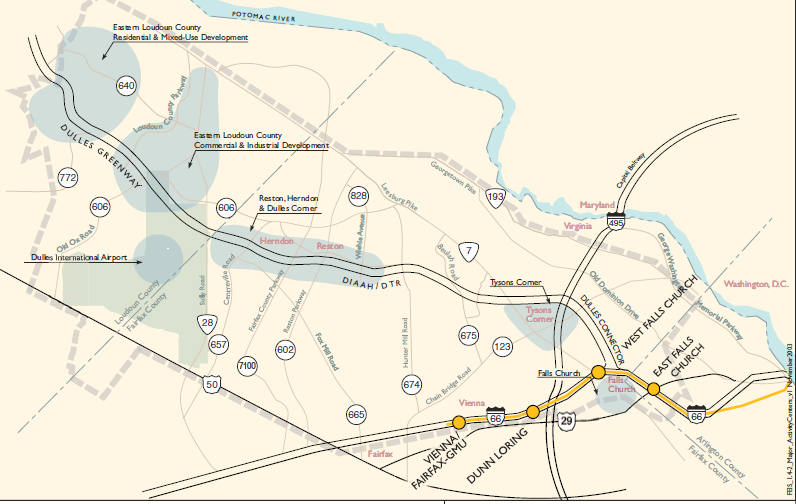
before the Silver Line: where would you locate the new Metrorail stations?
Source: Federal Transit Administration Final Environmental Impact Statement (EIS), Chapter 1
Figure 1.4-2, Major Activity Centers and Existing Transportation Network
The Silver Line, expanding the Metrorail network to Dulles, reflects a lesson learned the hard way by Fairfax County officials. When Dulles International Airport was completed in 1962, the Federal Aviation Administration acquired enough right-of-way for the access road median strip to include a future rail line connecting the airport to DC. Still, Fairfax County missed the opportunity - twice - to align Metrorail so it would go to Tysons, before deciding in the 1990's to include Tysons in a new extension to Dulles International Airport now known as the Silver Line.
The K route (now the Orange Line) was extended all the way to Vienna after the Washington Metropolitan Area Authority (WMATA) replaced the National Capital Transportation Agency in 1967. Plans for a subway focused on just the downtown DC area were expanded to include suburban jurisdictions, since they would help finance the project.

before the Silver Line: where would you locate the new Metrorail stations?
Source: Federal Transit Administration Final Environmental Impact Statement (EIS), Chapter 1
Figure 1.4-2, Major Activity Centers and Existing Transportation Network
When the original routes of extended Metrorail lines were determined in the 1960's, the population of Fairfax was growing rapidly, subdivisions were developed wherever there was sewage capacity - and in 1966, two supervisors and other officials were indicted for taking bribes related to land use cases. Some regional and county planners had a vision of using massive investment in new transportation infrastructure to transform the suburbs into job centers, but key officials in Fairfax were "scarcely paying attention" to the potential impacts of the future Orange Line.1
|
Fairfax supervisors treated the coming Metrorail system one-dimensionally. They viewed Metrorail just as a tool to transport workers to the job centers in DC like the Bay Area Rapid Transit System (BART) in San Francisco, rather than as an investment to stimulate economic activity where new stations were located. Arlington County officials re-routed Metrorail from the low-cost median strip of I-66, building an expensive tunnel to convert the Rosslyn-Ballston corridor into an urban development. In Fairfax County, however, the new rail line was routed down the interstate's median strip, to minimize construction costs.
There was minimal integration between land use and transportation planning in Fairfax. In 1962, Fairfax approved a new mall at Tysons Corner... but failed to align any Metrorail route to serve it when the Adopted Regional System was finalized in 1967. In the 1960’s, Fairfax supervisors relied upon the Northern Virginia Transportation Commission (NVTC) to reach consensus on Metro routes. Fairfax supported a route ending in Vienna rather than Tysons, in part because of the lower construction cost but also to obtain the vote of the NVTC commissioner from the independent city of Fairfax. According to the most-complete history of Metro:2
In 1978, Fairfax got a second chance to re-route the Orange Line to serve the emerging Edge City at Tysons, rather than build an end-of-line station in a low-density residential area near the edge of the Town of Vienna. Before another alternatives analysis in 1978, Fairfax officials had been presented with a clear choice by their planning consultants that invited the county to create what is now called Transit Oriented Development at new Metrorail stations:3
Fairfax re-affirmed the original route, leaving Tysons with no Metro access. In 1990, however, the Virginia Commonwealth Transportation Board determined that a rail line to Dulles was preferred, and funding should come from customers paying tolls on the Dulles Toll Road. In 1996, the Virginia Department of Rail and Public Transportation (DRPT) completed the Dulles Corridor Transportation Study (also known as a Major Investment Study or MIS). It determined rail to Dulles was feasible. In 1998 and 1999, two consortia of private companies proposed offering Bus Rapid Transit (BRT) service in the Dulles Corridor and building a rail line to the airport. Also in 1998, Congress began appropriating money for the project. In 2001, the General Assembly authorized Fairfax County and Herndon to establish special tax districts, so landowners near the new Metrorail line could be taxed to help finance the project.4
In 2002, the local jurisdictions agreed on the projected shares for funding the anticipated $4 billion in construction costs:5
Within the 25% for local/MWAA funding, the expected ratio was: Financing has not worked out as planned, however. |
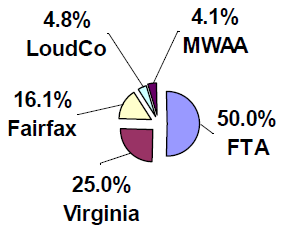 planned percentages of funding Source: Financing the Dulles Metrorail Extension (presentation to 2005 Rail~Volution conference)
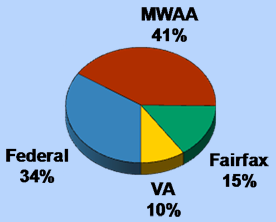 estimated percentages of funding for just Phase 1, as of 2011 (including Phase 2, Federal share drops to 17%) Source: Funding (Dulles Corridor Metrorail Project) |
The Locally Preferred Alternative considered in the Draft Environmental Impact Statement in October, 2003 broke the project into two phases, after the Federal Transit Administration said it could not fund the entire project at once. Phase 1 ended not at the Tysons West station, but at the Wiehle station - perhaps to reassure the MWAA, Reston/Herndon, and Loudoun County that all 23 miles of the line would be completed, out to the end of the line station at Route 772.
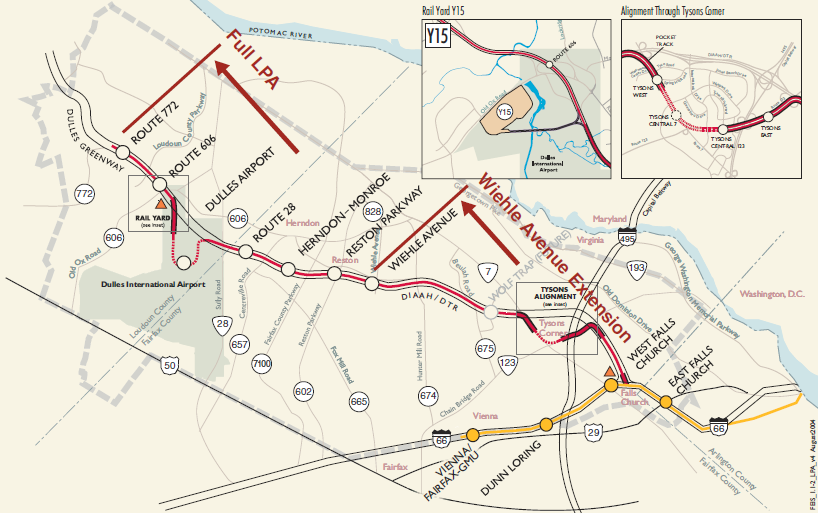
Separate Phase 1 and Phase 2 tax districts were established to generate local funds for each stage, but the boundaries and creation of the districts were controversial. Fairfax County created a "transportation improvement district" in 2004 to finance the county's 16.1% share of Phase 1 construction costs. An extra tax ($0.22 per $100 in value initially, and after $400 million is raised the tax will be ended) was imposed on commercial property within the boundaries of the special tax district. 6,600 businesses Commercial property owners controlling 64% of assessed value within the district voted to support the tax.6
According to the state law that authorized special taxing districts for transportation, residential property was excluded from paying the extra tax. Some commercial property owners included within the district boundaries voted against the tax, but they were still obliged to pay - even if their property was far from the Tyson stations.7 Herndon declined to join the initial tax district, and the Phase 2 tax district was not approved until 2009.8
The Federal Transit Administration tried to cancel the project in 2008,9 but political pressure resulted in restoration of Federal funding. Ballooning costs blocked a proposal to bury more than 0.4 mile of the rail line in a tunnel at Tyson. By 2010, costs for the entire 23-mile Silver Line were projected at $5.2 billion. The Federal government capped its contribution at $900 million (all for Phase 1), and the state limit for Phase 1 was set at $275 million. Users of the Dulles Toll Road will end up paying for most of the additional costs. To reduce costs of Phase 2 to below $3 billion, MWAA was forced to eliminate the tunnel at the airport and to adopt an above-ground station there. In addition, parking garages originally included the Phase 2 project were deleted, but the Federal government will provide loans to Fairfax and Loudoun counties to build those garages.10
Fairfax County officials now consider rail connections to be essential to economic development, through "smart growth" at Tysons and Reston. In 2007, when the Federal Transit Administration announced plains to block funding for the project, the president of the Fairfax County Chamber of Commerce wailed "It's our whole growth strategy."11
Through replanning/rezoning at Tysons and Reston, the county will create new urban centers. Even Vienna, the end of the Orange Line, will get new development as the old Fairlee subdivision is replaced by the MetroWest center.
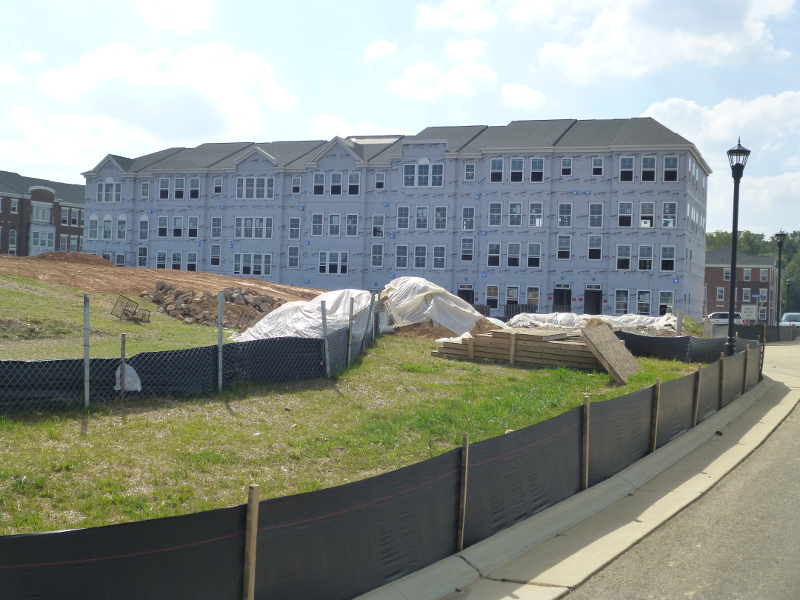
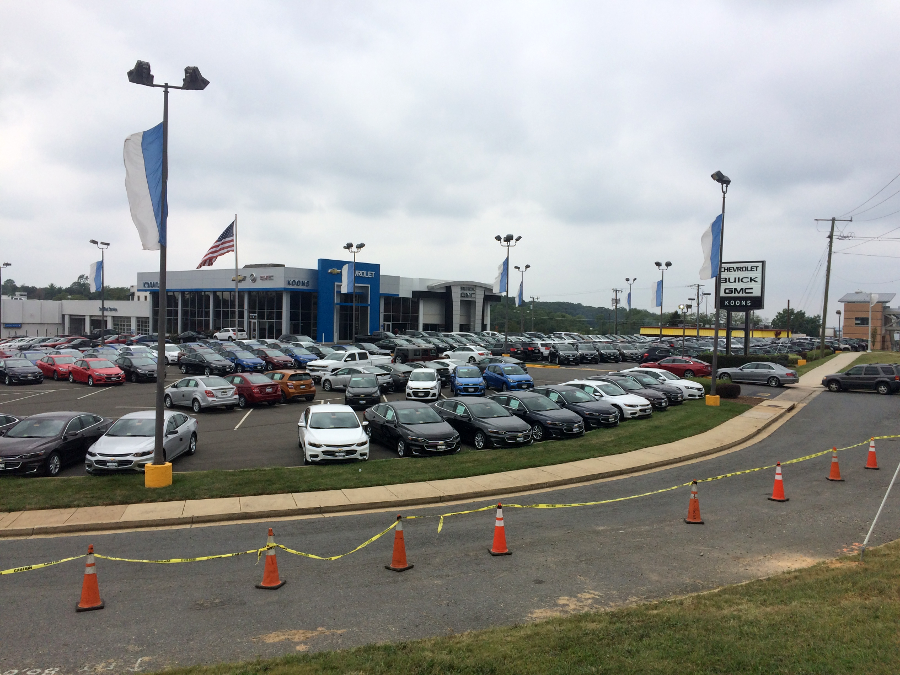
car dealerships at Tysons were replaced by higher-value office buildings, after the Slver Line was completed